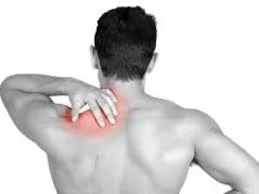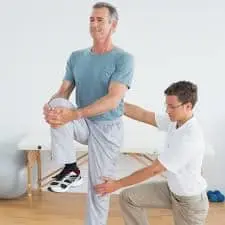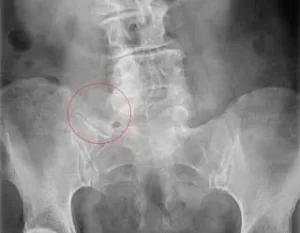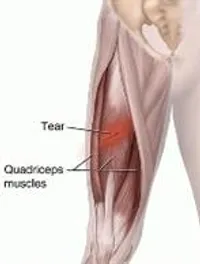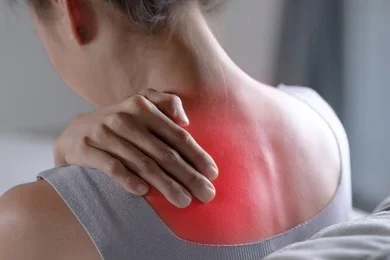Trapezitis
Trapezitis: What is it?
Trapezitis, also known as trapezius muscle strain or trapezius myalgia, is a condition characterized by inflammation and pain in the trapezius muscle, which extends from the back of the neck to the shoulders and upper back.
Neck soreness and spasms are further symptoms of trapezius, an inflammation of the trapezius muscles. It is growing more and more prevalent among those who use computers and work at desks, as well as those who perform manual labor or frequently strain their neck and back muscles. Understanding trapezitis’s causes, symptoms, and suggested treatment is crucial for efficient management.
Although the muscle is responsible for many of our body’s primary activities, raising the head and shrugging off the shoulder are the two most crucial ones. In addition, the bulk of the muscles in the back help to stabilize, rotate, and move the shoulder blade. The largest portion of the upper back and the lower part of the neck are covered by the broad, flat muscle that gives discomfort to the back. However, because the trapezius is a large muscle, inflammation or trapezius in it can cause severe pain and hinder the movements that go along with it.
Usually lasting three to five days, the pain associated with trapezius is temporary. Two of the primary reasons for the soreness are fatigued muscles and stress. Not only that but one of the main causes of discomfort is also thought to be poor posture. People who must hold their heads steady for extended periods are more likely to develop trapezitis. Therefore, the majority of people who drive long distances or work on computers for extended periods suffer from trapezitis.
Trapezius Muscle Anatomy
The huge, agreeable muscle known as the trapezius extends from the base of the skull to the lower thoracic vertebrae and continues laterally to the scapular spine. There are three useful components to it:
- Upper (descending) fibers: These fibers enter the clavicle from the base of the head. They aid in head rotation and raise the scapula.
- Middle (transverse) fibers: These fibers enter the acromion process of the scapula after emerging from the spinous processes of the upper thoracic vertebrae. They aid in shoulder adduction and scapula retractions.
- Lower (ascending) fibers: These fibers enter the scapula’s spine after emerging from the spinous processes of the lower thoracic vertebrae. They aid in shoulder rotation by depressing the scapula.
The ventral rami of C3 and C4 as well as the spinal accessory nerve (cranial nerve XI) innervate the trapezius muscle. It is supplied by the transverse cervical artery as well as the dorsal scapular artery.
Numerous actions require the trapezius muscle, such as:
- Elevation of the scapula
- Depression of the scapula
- Retraction of the scapula
- Rotation of the scapula
- Elevation of the clavicle
- Depression of the clavicle
- Rotation of the head
- Adduction of the shoulder
- Extension of the shoulder
- Lateral flexion of the neck
Additionally, the trapezius muscle aids with balance and posture maintenance. It keeps the shoulders level and supports the weight of the upper body.
Nerve supply of trapezius muscle:
Two distinct nerves innervate the trapezius muscle:
- The spinal accessory nerve, also known as Cranial Nerve XI, gives the trapezius muscle its motor innervation, which enables it to contract and carry out its different tasks.
- The trapezius muscle receives sensory innervation from the ventral rami of the C3 and C4 spinal neurons, enabling it to perceive pain, temperature, and proprioception—the awareness of one’s body’s location in space.
Blood supply of trapezius muscle:
Three major arteries give blood to the trapezius muscle:
- The main blood supply to the trapezius muscle is the transverse cervical artery. The superficial and deep cervical arteries receive their branches from the subclavian artery.
- Scapular dorsal artery: The bottom portion of the trapezius muscle is supplied by this artery. It originates from either the third segment of the axillary artery or the subclavian artery.
- The bottom portion of the trapezius muscle receives increased blood flow from the posterior intercostal arteries, which originate in the thoracic aorta.
What Causes Trapezitis?
The moniker refers to the muscle’s trapezoid shape. Bands of muscle fibers comprise the trapezius. The superior, middle, and inferior muscle fiber bands make up the three bands. The condition known as trapezitis occurs when a person experiences inflammation in any one of these three bands.
The following are a few typical causes of trapezius:
- long-term employment in the same role.
- spending a lot of time reading a book in an uncomfortable position.
- long-distance driving.
- spending a lot of time watching television in a fixed or uncomfortable position.
- Breastfeeding mothers are also susceptible to trapezius, particularly if they bow their shoulders when nursing their infant.
Some persons may also get trapezius as a result of weak neck and back muscles brought on by traumas or other medical disorders.
Trauma, falls, and impacts to the neck or back can all cause trapezitis.
Acute pain and problems might result from straining the body’s trapezius muscle for the reasons listed above. In today’s world, a lot of people get pain from overusing or misusing their muscles at work or at home.
The signs of Trapezitis:
The first signs and symptoms of trapezius are usually minor and start with some neck pain.
Among the symptoms of trapezius that people frequently encounter are:
- The head of the neck hurts, commonly in the evening or at night after a long day of driving or working.
- The only way to repair or treat tense, stiff muscles is to give the patient a good night’s sleep or a nice massage.
- People are known to continue to experience the following issues after the early stages of trapezius have passed;
- Additionally, neck spasms may make it difficult to move.
- When trapezius discomfort persists for a long time, it becomes increasingly problematic and can be triggered by even the smallest tension or trigger in the trapezius.
- A person may experience neck and trapezius muscle pain and tightness for three to five days on average.
- The patient may also report hand and arm pain during this stage of trapezitis.
In certain cases of trapezius, especially those involving prolonged standing, the persistent muscular contraction may also result in nerve compression. This frequently leads to further Trapezitis symptoms in the affected person, such as tingling, numbness, or even weakness in the arms, hands, and fingers.
The symptoms listed above are some of the typical ones that people with Trapezitis may experience. It is advised that patients who are frequently observed to be experiencing these symptoms consult a specialist and begin a workable treatment plan.
How do I know it’s the Trapezius?
To ascertain whether or not the Trapezius is affected, one must look for certain signs and symptoms. The following are typical signs of trapezius pain:
- Neck pain or stiffness
- restricted movement of the neck
- Upper back and shoulder pain
- numbness in arms
- Excruciating spots or tight bands in the upper back
- Upper back and neck pain
- fluid retention
- Spasms or twitching of the muscles
- trouble with head twisting or neck movement
- Headache
- Arms weakness
Instead of being typical, these symptoms point to the involvement of Trapezius. Indeed, the medical practitioner may request certain diagnostic procedures, such as X-rays or, if necessary, MRI or CT.
Diagnosis of Differentiation
The following are common differential diagnoses or disorders that may exist in addition to trapezius pain:
- Cervical spondylosis – Neck pain may be the first sign of cervical spondylosis, a degenerative disease of the vertebral body and intervertebral disc.
- Cervical osteoarthritis – Osteoarthritis of the cervical region is a degenerative condition that is typically brought on by aging.
- Cervical radiculopathy – For a variety of reasons, the nerves that emerge from the cervical region may get pinched or irritated, resulting in discomfort in the neck that typically radiates down the arm, sometimes stopping at the elbow and other times ending in the tips of the fingers and thumb.
- Thoracic Outlet Syndrome – Innumerable thoracic and cervical blood vessels and nerves can travel via the thoracic outlet, which is the area between the first rib and the collarbone. Thoracic outlet syndrome occurs when the gap narrows and the structures that pass through it are compressed as a result of certain illnesses. disorders of the shoulders, such as tendinitis, tendinopathy, osteoarthritis, and rotator cuff injuries.
- Impingement syndrome – Bony spurs or soft tissue damage may cause the nerve to become inflamed along its journey.
- Herniation of the cervical disc – The intervertebral disc between the vertebrae may protrude from its position and irritate the nerve roots it compresses.
How to Treat Trapezitis
Conservative treatment for Trapezitis involves the use of medications such as muscle relaxants, analgesics, and anti-inflammatory drugs during painful neck spasm episodes. This should be used in conjunction with rest or physical therapy.
Using a variety of techniques (such as ultrasound, moist heat, ice, IFT, TENS, ACLT, etc.) or teaching you proper posture, neck stretching, or strengthening exercises, particularly for the Trapezius muscle, a physiotherapist may assist you in releasing the muscle spasm by releasing the trigger points.
To help the stretched trapezius muscle fibers relax, take a break.
To reduce swelling and inflammation, apply a cold compress or ice pack to the affected area for ten to fifteen minutes.
To avoid harming the skin and making the issue worse, avoid putting the pack directly on it.
In the morning, practice breathing techniques like yoga to enhance posture and encourage healthy blood flow in the region. This will lessen the likelihood that the issue will repeat and aid in a speedy and healthy recovery.
Use a comfy pillow to keep your neck and spine in the right alignment, maintain good posture, or avoid back or neck pain or strain.
To avoid trapezius muscle spasms, apply heated coconut oil or olive oil to the sore spot.
Avoid carrying heavy objects on your back.
The pain caused by Trapezitis can be reduced by wearing a cervical collar. Additionally, it stops needless movement and keeps the problem from getting worse. Only the first week following the issue is spent wearing this cervical collar. I advise against using a cervical collar for an extended period because it can lead to more issues.
Physiotherapists to ease the Trapezius Muscle Pain
Goals of Physiotherapy:
- Improves pain through advanced modalities
- Reduces tightness
- Reduces inflammation
- Reduces spasm
- Reduces tightness
- Increases strength: resisted band exercises
- Alignment correction through manual therapy
- Taping technique
- Laser therapy for instant pain relief
- Reflexology
Physiotherapeutic Approach:
To relieve pain:
Laser therapy
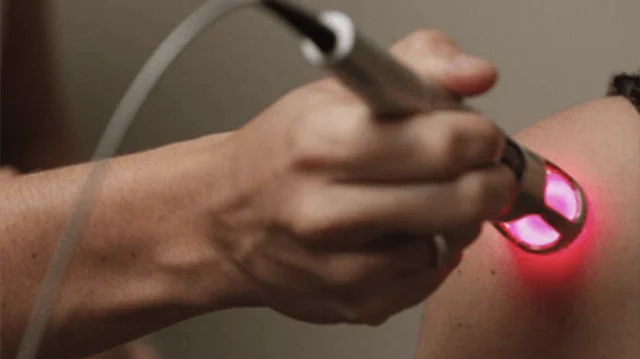
Transcutaneous electrical stimulation
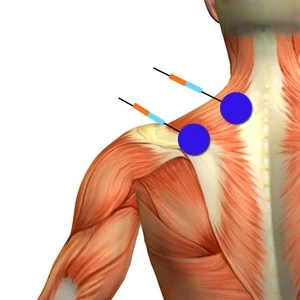
Cold pack and myofascial release:
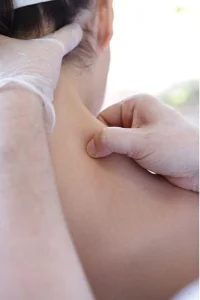
Correction:
Postural correction using ergonomic guidance and taping technique.
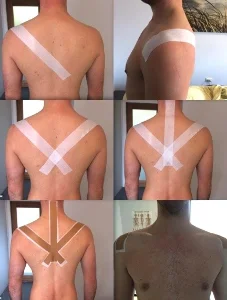
Stretching:
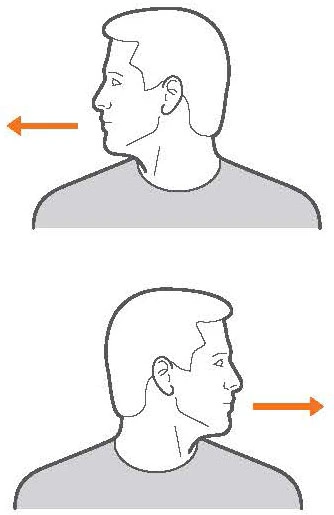
Maintain a straight head and back while sitting or standing. To align your head with your shoulder, gently move it to the right. Return to the middle. The identical move must be repeated to the left.
Apply a light, leisurely motion.
The position is not required of you. Your joints may become more flexible as a result of the exercise, which also relieves muscle stress.
Both sides of your neck should be stretched.
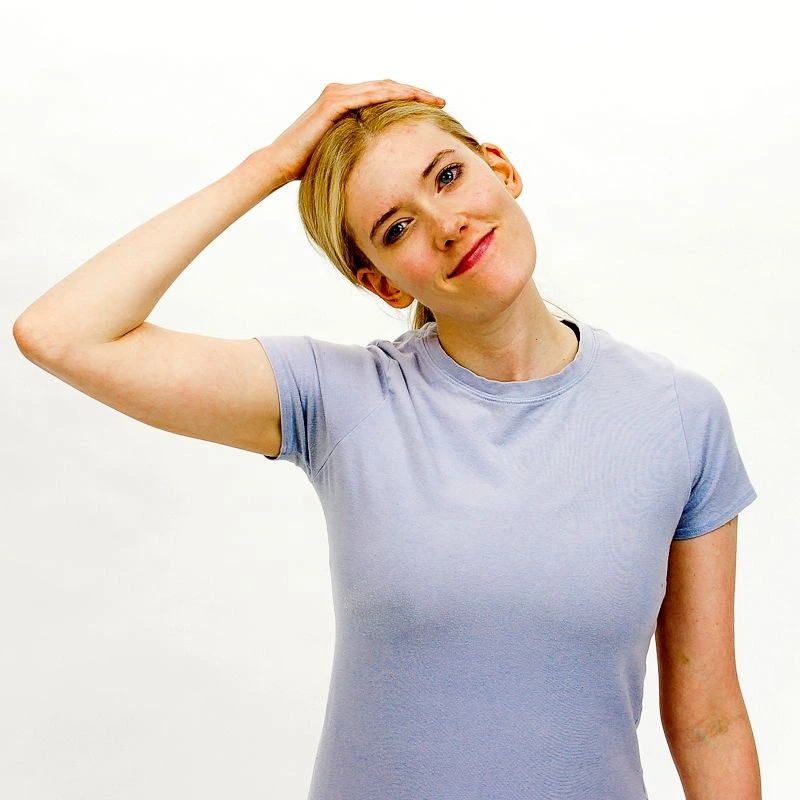
With your nose pointing forward, tilt your head to the left while sitting or standing. Cover your ear with your left hand and apply a slight pressure. Make a crawling motion with your other hand under your shoulders. To make sure you’re keeping it down and to the back, touch your shoulder blade. For 30 seconds, maintain the position.
Likewise, bend toward each other’s right.
Don’t let your head fall to your shoulder; instead, tilt it.
Hug yourself like a bear.
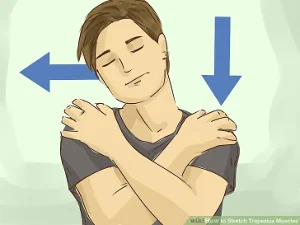
Get to your feet. Hold your right shoulder while extending your left arm over your chest. Oppositely use your right arm. Employing your right hand, apply under pressure to your left shoulder region. To stretch the muscle, tilt your head forward and to the right while you do so. For 30 seconds, maintain the position.
On the opposite side, repeat the procedure.
Put a pencil between your shoulders and act as though you are.
Get to your feet. Bring your shoulder blades back and together as though you were attempting to hold a pencil there. Once you have retracted your shoulders, push them into your ribcage.
After a few seconds of holding this position, begin again at the beginning. To stretch your muscles, repeat the exercise multiple times.
To relieve tension, wrap a long, wide belt around your back.
You can join two ordinary belts or use a yoga belt. Place it above the central region of your back, just below your upper back. The end that emerges from the right should pass over your right shoulder. Take the two ends in front and hurl them over the corresponding shoulders. Move each end across your back and back to the front once more. To tighten the straps across your stomach, gently tug. Whenever you do your best to help your trapezius muscles take it easy and get out. Once the two ends of the belt are back in front, you can also buckle it. Put it on for as long as you want and tighten it as much as feels comfortable.
Using techniques for self-massage
To warm the area, apply wet heat or dry heat.
To warm the muscle, try placing a heating pad over it for 20 minutes or so. As an alternative, consider soaking your shoulder muscles in a warm bath or shower for five to ten minutes.
Additionally, you can use items from your home to create your heating pad.
The sides and back of your neck should be kneaded with the other hand.
With your left arm folded over your chest, raise your hand to your right shoulder. As you would with dough, massage the muscle below the shoulder. As you carefully slide your arm behind your right shoulder, kneel. Put on just enough pressure to feel it, but not enough to cause pain. On the opposite side, repeat the procedure. If you’d like, you can repeat both shoulders two or three times.
Get on your knees and carefully move your arm down your right shoulder.
Press down on the area that is hurting using your fingertips. Hold for up to a minute after pushing down until you feel it. It should begin to relieve the strain.
The typical trigger points are located in the middle of your spine, directly above the area where your shoulder blades meet, or to the right or left of your spine, wherever your shoulder blades and neck meet in the back.
An alternative is to use a pressure tool, like a Backnobber, which is a long, curved stick with knobs on the end for massaging your own back if you’re having problems getting to the area with your fingertips. These allow you to exert pressure on different areas of your back because they are longer.
altering one’s lifestyle to alleviate suffering.
During the day, sit and stand upright.
Make sure your head is back and your shoulders are down as you do this. Imagine your body being raised by a thread, which would keep you standing.
Your trapezius muscles will be less stressed if you have proper posture.
Additionally, refrain from doing things that cause you to hunch on one or both shoulders, such as carrying a phone on one shoulder.
Sleep on your side so that your head stays up straight.
Your head is always turned to one side when you sleep on your stomach, which strains your trapezius muscles. Instead, try sleeping on your side, which prevents your head from turning to the side.
You can also sleep on your back if your head doesn’t tilt to one side.
Avoid bringing a bulky shoulder bag or backpack.
Your trapezius muscles might be strained by a heavy bag. Try a belt purse instead, and only bring the necessary items.
If you have a piece of bigger luggage to handle, consider a rolling briefcase.
Make careful to swap off shoulders if you have to carry a shoulder bag.
In a similar vein, your trapezius muscles may be overworked by tight bra straps. Be sure to get a bra fitted correctly.
To avoid sagging, raise your electronics.
Your trapezius muscles may become uncomfortable from slouching over, and you may find yourself drooping a lot while using a computer or smartphone. Even while you might have to hold your smartphone in front of you, it’s preferable to sagging.
To raise your laptop or screen to eye level or higher if you work at a desk, consider purchasing an elevated stand.
Make that the armrests and keyboard are at the proper height.
Because the weight of your arms can eventually strain your muscles, work in a chair with armrests. Additionally, when you sit upright with your elbows at a correct angle, make sure your arms are level with your keyboard. Typing shouldn’t need you to raise your arms.
Consider using a keyboard shelf if you must lower your keyboard.
Enhancing Range and Strengthening:
- trapezius positional release method.
- Exercises were difficult for Theraband.
- workouts to strengthen the upper body.
Lifestyle Modifications for Pain in the Trapezius:
There are easy methods to lessen or avoid pain in the trapezius muscles, such as
How quickly the activities are conducted
It is an easy method to prevent overuse injuries.
Give your muscles enough time to recover and relax by taking frequent breaks from your work or activities.
If you’re a student, for example, you can time your studies such that you write for an hour or two, take a quick break to stretch your muscles.
Stretching Every Day
Include stretching in your everyday activities.
This helps to maintain the muscles’ flexibility and lessen their tightness.
Because of the slouched posture that is so popular these days, the trapezius is the most used and tight muscle in the body. Aside from this constant sitting employment, trapezius workload has increased due to hunching over computers, laptops, and mobile devices for business and play.
Biofeedback
Every two to three hours, you can evaluate your posture on your own.
For instance, when using a computer or laptop, try to maintain a neutral head position, relaxed shoulders, and relaxed wrists and forearms.
You can use sensor devices that notify you when your posture may be off-kilter or work in front of a mirror.
Precautions and Safety
- Stop the stretch and exercise you are doing if the patient feels any discomfort, numbness, or even pinching while completing any of these stretches.
- As you relax the muscles in your face, neck, and shoulders, take deeper, more even breaths.
FAQs
Trapzitis: What is it?
Inflammation of the trapezius muscles causes Trapezitis, which also causes neck pain or spasms.
What signs of Trapezitis are present?
Among the symptoms of Trapezitis are:
Neck or trapezius muscle pain or stiffness
Pain in the upper shoulder area
Excruciating neck ache
Which Factors Lead to Trapezitis?
exhaustion, stress, or tension
Defective activities of daily living (ADL) and strenuous repetitive motions
Sitting for extended periods without back support
Head posture forward
lugging around bulky bags or backpacks
Is it possible to heal Trapezitis?
Physiotherapy is a rapid treatment for trapezitis. The most frequent cause of this inflammation of the trapezius muscle is improper activity during yoga or gym poses, however, it can also be brought on by stress, poor posture, or a heavy workload from a desk job.
How can Trapezitis be recognized?
The first signs and symptoms of Trapezitis are usually minor and start with some neck pain.
Does a massage relieve discomfort in the trapezius?
It has been demonstrated that massage improves mobility in the afflicted areas and lessens pain related to trapezius strain.
How severe is trapezius pain?
Maintaining an active lifestyle, stretching frequently, and maintaining proper posture can reduce your risk of suffering from a trapezius muscle strain, which can be excruciating and restrict your range of motion. A trapezius muscle strain is usually treatable at home, but if the pain is severe or continues, you should consult a physician.
References
- Jyoti. (2023, August 30). Trapezitis – Cause, Symptoms, Treatment, Exercise. Samarpan Physiotherapy Clinic. https://samarpanphysioclinic.com/trapezitis/#Anatomy_of_Trapezius_Muscle
- Jbadmin. (2022, December 28). Trapezitis | Trapezius | Physiotherapeutic | Therapy | Wet Heat | Fingertips. Spectrum Physio. https://www.spectrumphysio.info/what-is-trapezitis-how-is-it-treated/
- Pansari, Y. (2022, August 10). Trapezius Muscle Pain Cause, Treatment, Exercise | Mobile Physio. Mobile Physiotherapy Clinic. https://mobilephysiotherapyclinic.in/trapezius-muscle-pain/#How_can_I_be_certain_it_is_the_Trapezius

